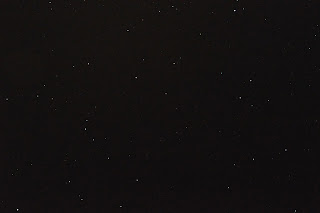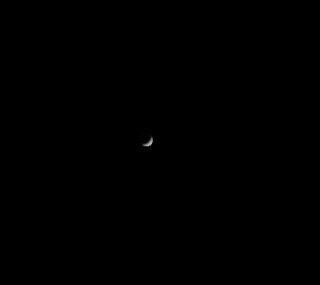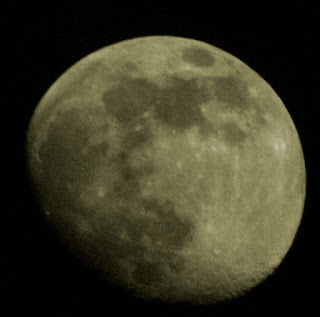May 31st 2020 GMT Moon
I used the same settings as the day before to capture the Moon with my DSLR.
May 31st 2330 GMT Moon and Meteors
I snapped the Moon with my DSLR at 300mm focal length, ISO
100 and 1/250 second exposure.
The region of sky where the Tau Herculid meteors might have
been was bathed in moonlight. The area around Lyra and Draco seemed to be the
darkest part of sky, so I aimed my camera there and set it at 18mm focal
length, ISO 6400 and 6 seconds exposure. I did not detect any meteors.
May 29th 2230 GMT Moon
It was a bit hazy but I had a go at the Moon with my DSLR at 300mm focal length, ISO 100 and 1/250 second exposure.
May 29th 2355 GMT Meteor Hunt
I would have started earlier but the Moon was high. I waited
until it was low and behind a tree. Like the last attempt, I aimed the camera
at the Corona Borealis/Hercules region.
I caught a bright meteor near Corona Borealis at 0002 GMT. It was another candidate Tau Herculid.
May 28th 2030 GMT Moon
I snapped the Moon at 300mm focal length, ISO 400 and 1/160
second exposure. The first set looked over-exposed, so I reset the ISO to 100. The second set gave the best results.
May 28th 1505 GMT Sun
I took some full disc solar shots, having seen a fairly
active disc on the professional images and reports of prominences from amateurs
with advanced equipment. Sad to say but true, my PST did not deliver.
May 26th 2240 GMT Meteor Hunt
I had a shorter session, as I needed to be up in the morning
the next day. I aimed my camera slightly south of the zenith, as there was a
chance of seeing a Tau Herculid. If I could get a second match, it might
suggest that at least one was a true shower meteor.
Unfortunately, I had the wrong camera settings and poor focus, so could not obtain anything useful.
May 26th 2035 GMT Moon
I could find neither Venus nor Mercury but it was quite cloudy near the horizon. However, I managed a nice shot of the Moon with my DSLR at 300mm focal length, ISO 400 and 1/200 second exposure.
May 26th 0120 GMT Jupiter, Saturn and the Andromeda Galaxy
I could not resist a last quick session before bedtime. I
snapped Jupiter and Saturn at 300mm focal length, ISO 6400 and 2 seconds
exposure in an attempt to capture the moons.
I caught three of Jupiter.
I went back to 300mm focal length to capture the Andromeda
Galaxy (M31).I stacked 8 images and caught some of the wider galaxy.
May 25th 2250 GMT Meteor Hunt
I ran out of luck the night before but had another go, using
the same settings in the same part of sky.
At 2328 GMT, I caught a faint meteor in Bootes, near Corona Borealis, which was quite poossibly an elusive Tau Herculid meteor.
I caught a nice, bright sporadic meteor at 0057 GMT.
May 25th 2035 GMT Moon
I was too tired to drag a telescope outside, so I went out
with my DSLR alone. I could not find Mercury or Venus but I caught the Moon at
300mm focal length, ISO 400 and 1/200 second exposure.
May 24th 2250 GMT Meteor Hunt
There was a bit of thin cloud around, enough to dissuade me
from doing some constellation and deep sky shots but it did not stop me from
hunting for meteors. There was an irregular shower, the Tau Herculids that
could have been active but I figured that I would cover part of the area if I
aimed at the zenith, as usual, for sporadic meteors. I did not catch any meteors.
I processed a single frame from near the start of the session to show Bootes and Corona Borealis.
May 24th 2045 GMT Moon, Venus and Mercury
Conditions were not perfect, with some cloud low in the
north west. However, the Moon and Venus were clearly visible, so I decided to
proceed. I used my Maksutov and DSLR together at ISO 800, 1.54 metres and 4.62
metres focal length and from 1/100 to 1/10 second exposure. The only thing I
was unable to do was to catch Mercury at the longer focal length, probably
because it was faint.
First up was the full lunar disc.
Then Venus at the same settings, with the false colour removed.
I then took some sets of Moon shots at 4.62 metres focal length and stitched and stacked them.
I tried to stitch the originals to obtain a composite full disc shot but it did not work. However, I managed to get an image of Venus at the longer focal length.
Mercury was approaching half phase.
After that, I tried some widefield shots in case I was able
to catch all three objects together. It needed some processing to bring Mercury out from the twilight but it worked.
May 22nd 2030 GMT Venus and Mercury
My plan was to catch Venus and Mercury in the same widefield frame but it was too cloudy. I used my Mak and DSLR to deliver 1.54 metres focal length, ISO 400 and 1/100 second exposure and I caught Venus as a very thin crescent.
Mercury's disc was much smaller but I managed a better approximation of its gibbous phase than with the DSLR two days before. I also increased the ISO setting to 800 and the exposure time to 1/40 second.
I was hoping to try increasing the focal length to 4.62 metres but I lost the rest of the session to cloud.
May 21st 0120 GMT Jupiter and Saturn
It had clouded over quite a lot since my previous shots but
Jupiter and Saturn were visible low in the south west. I thought it best to
wait until both planets were higher in the sky during the summer evenings. I
took some shots of Jupiter at 200mm focal length, ISO 6400 and 2 seconds
exposure in an attempt to capture its moons.
May 21st 2310 GMT Constellations and Meteor Hunt
There was a bit of thin cloud around but I decided to have a pot at a couple of projects I had considered for a while. I set my DSLR to 18mm focal length, ISO 1600 and 30 seconds exposure.
My first set of frames was aimed at Draco, with the idea of stitching a panorama of the whole constellation.
I tried single frame shots of Cassiopeia, Cygnus and Hercules.
The Cassiopeia shot also caught Cepheus.
The Cassiopeia shot also caught Cepheus.
My Cygnus shot also caught Lyra, Sagitta and Delphinus.
I then tried a different approach with meteors with 18mm focal length, ISO 6400 and 10 seconds exposure.
I caught a faint one near Corona Borealis at 0004 GMT.
I caught another one at 0039 GMT, near Draco's head.
The Hercules shot also caught Lyra and Corona Borealis.
I caught a faint one near Corona Borealis at 0004 GMT.
I caught another one at 0039 GMT, near Draco's head.
May 20th 2025 GMT Venus
I took another set of shots, as Venus continued to swing towards inferior conjunction. Usual settings.
I saw Mercury in my camera viewfinder. I had a go but should have used higher ISO or longer exposure. It was also out of focus but it was my first non-Venus planet shot of the year! A but of digital wizardry extracted something like the phase.
May 20th 1300 GMT Sun
Despite my attempts to clean my optics, I made them worse. At least some surface features showed. Enough said.
May 19th 2220 GMT Lyra and Meteor Hunt
I took a few frames of Lyra with Draco’s head at 18mm focal
length, ISO 1600 and 30 seconds exposure. I also caught Hercules and much of Cygnus.
Afterwards, I aimed my camera at the zenith to take repeated
shots at 18mm focal length, ISO 6400 and 6 seconds exposure.
I caught a faint sporadic meteor in Hercules.
May 19th 2030 GMT Venus
I had some clear sky to the west and snapped Venus with my DSLR at 300mm focal length, ISO 100 and 1/200 second exposure. I could see that the phase was clearly shrinking.
May 19th 1145 GMT Sun
I had not looked at the Sun much, despite some good daytime
weather. It had been inactive and it had been difficult to see or photograph
much with a Coronado PST. I persisted with my zoom eyepiece and took some
afocal shots with my DSLR, covering full disc and close-up images. I did not
see much visually.
May 16th 2055 GMT Venus
Venus was visible after sunset but there was a lot of cloud about. I also tried for Mercury but could not see it. Venus showed a phase of about 30% in my binoculars.
May 15th 2125 GMT Venus
I had taken some DSLR shots earlier as a Plan B. Plan A did not work to plan because I was only to use my Mak with my DSLR at 1.54 metres focal length, ISO 100 and 1/100 second exposure. I was going to use my 3x Barlow lens to increase the focal length to 4.62 metres but cloud rolled in before I could take the shot. As it was, I caught some cloud features near the venusian poles.
May 13th 1930 GMT Venus
I snapped Venus through a gap in the cloud at 300mm focal length, ISO 200 and 1/160 second exposure.
May 13th 2340 GMT Deep Sky
It was rather clear for a change, so I decided to do some
wide deep sky shots. I set my camera to 70mm focal length, ISO 6400 and 6
seconds exposure. I took a few exposures of Melotte 111. I stacked the best 20 of 25 images.
I had an optimistic try at M81 and M82. It was optimistic and I caught nothing of interest.
Having seen a few stars around the Plough handle while
hunting for meteors, I took a few frames there.
I had a go at Canes Venatici but was not sure whether I had
pointed the camera properly. I did not.
May 11th 2135 GMT Meteors
It was still twilight. Vega had risen quite noticeably above
the horizon since the Lyrid meteor shower. With no shower radiant above the
horizon, I aimed my camera at the zenith, following recent successes in that
area. I used my normal settings of 18mm focal length, ISO 6400 and 6 seconds
exposure.
I detected a faint meteor at 2257 GMT.between Coma Berenices and Canes Venactici.
At 2317 GMT, I caught a faint meteor with a short trail in Bootes.
May 11th 2055 GMT Venus
Venus was getting much lower in the sky. I took some quick
shots with my DSLR at 300mm focal length, ISO 100 and 1/250 second exposure.
May 9th 2255 GMT Meteors
I wanted to do some deep sky and constellation shots but it was too cloudy. The conditions were quite similar to the night before, so I decided to attempt to catch more sporadic meteors.
At 2309 GMT I caught a bright meteor, of mag. 0 or brighter near the Plough handle.
At 0044 GMT, I caught a fainter one in Draco.
At 2309 GMT I caught a bright meteor, of mag. 0 or brighter near the Plough handle.
At 0044 GMT, I caught a fainter one in Draco.
May 9th 2100 GMT Venus
Conditions were not great, with a lot of cloud. I snapped Venus with my DSLR at 300mm focal length, ISO 100 and 1/160 second exposure.
May 9th 1045 GMT Sun
I had seen some prominences on the Big Bear images, so
decided to have a try with full disc and close-up shots of the Sun with my PST
and DSLR.
The full disc shots were ruined by dirty optics (OK, my fault!) but some of the close-ups worked.
May 8th 2210 GMT Meteors
Conditions were not great and the Aquariid meteor shower was
not due to rise until late at night, when the Moon would be bright.
I aimed at the zenith, being my best chance. I used my
normal settings of 18mm focal length, ISO 6400 and 6 seconds exposure.
I caught one in Ursa Major, near the Plough, at about 2215 GMT.
I caught one in Ursa Major, near the Plough, at about 2215 GMT.
May 8th 2200 GMT Moon
The Moon was low in the south west and a rather attractive
coppery colour, similar to that of a full moon. I snapped it at 300mm focal
length, ISO 100 and 1/200th second exposure, due to the low
elevation.
May 8th 2300 GMT Moon
I had a frustrating evening waiting for the sky to clear
enough to photograph the Moon. I used 300mm focal length, ISO 100 and 1/400
second exposure. The cloud and moonlight obscured all but the brightest stars,
making constellation, deep sky and meteor shots impossible.
May 6th 2100 GMT Moon
By popular culture, this moon was known as the "supermoon" because it was much closer to Earth than average. This term is not recognised by astronomers who call it a "Perigee Moon" instead. Also, it was 14 hours before the actual full moon, although this photo shows a moon that is difficult to tell from a true full moon without zooming in.
I used 300mm focal length, ISO 100 and 1/400 second exposure.
May 6th 0950 GMT Sun
The Sun looked quiet in hydrogen alpha light but I
persevered, knowing that some amateurs (with better equipment than me) had been
capturing prominences. I took some full disc shots, as usual, but also
attempted some close-ups.
May 5th 1955 GMT Moon and Venus
We both had bodyaches from DIY work, so I was not able to
carry a telescope out. A 300mm zoon lens is no direct substitute but gave me a
chance to do some imaging. I snapped both objects with my DSLR at 300mm ISO 100
and 1/400 second exposure.
May 5th 2330 GMT Moon
I was going to have a session with my Mak and Bresser
Electronic Eyepiece. However, I had technical problems, so used my DSLR and Mak
to shoot the Moon. Conditions were hazy, so maybe it was better under the
conditions. I used a 3x Barlow lens giving a focal length of 4.62 metres, ISO
400 and 1/10 second exposure.
May 4th 1840 GMT Moon
With a discouraging weather forecast for later, I snapped
the Moon with my DSLR at 300mm focal length, ISO 400 and 1/500 second exposure.
I reduced the exposure time, due to overexposure a couple of days earlier. I didn't have the same problem this time, although the photo was slightly "grainy".
May 2nd 2030 GMT Moon and Venus
The Moon shot was a great improvement from earlier in the day.
The Venus shot was the cleanest I had achieved without a telescope, with the only editing being for false colour.
May 2nd 1615 GMT Moon
Like the day before, it was a case of cloud-dodging. I found a clear patch and snapped the Moon at 300mm focal length, ISO 400 and 1/200 second exposure. Honestly, I had overexposed the image but it showed some detail near the terminator.May 1st 1900 GMT Moon
Fortunately, there was a clear patch of sky before sunset. The Moon was showing the crater Clavius, as it was just past first quarter.
May 1st 1150 GMT Sun
It seemed as if the month of May started in the same way
that April ended. I had to do some cloud-dodging to catch the Sun in hydrogen
alpha light. It continued to be quiet.

































































































